Overview
The article “Mastering DAX ISNULL Functions: An In-Depth Tutorial for Data Analysts” focuses on how the DAX ISNULL function can be effectively utilized to manage null values in data analysis, enhancing data integrity and reporting accuracy. It supports this by outlining practical applications, best practices, and troubleshooting tips for ISNULL, emphasizing that proper handling of null values is crucial for reliable analytics outcomes and informed decision-making in business intelligence contexts.
Introduction
In the world of data analysis, understanding how to effectively manage null values is paramount for ensuring accuracy and integrity in reporting. As organizations increasingly rely on powerful tools like DAX and Power BI, the challenge of addressing missing data can significantly impact decision-making processes.
By utilizing functions such as ISNULL, analysts can replace null entries with meaningful alternatives, enhancing the clarity of reports and fostering a data-driven culture. This article delves into the importance of recognizing and addressing null values, offering practical applications and best practices that empower data professionals to optimize their workflows and drive operational efficiency.
By mastering these strategies, organizations can transform raw data into actionable insights, paving the way for informed decisions and sustained growth.
Understanding Null Values in DAX: A Foundation for Data Analysis
In the domain of DAX, the dax isnull function can help identify missing entries, indicating the lack of information within a specific field, which is essential to comprehend for achieving precise reporting. Struggling with these null values can be a significant challenge, especially when dax isnull is not utilized for leveraging insights from Power BI dashboards. Neglecting to address these gaps can lead to misleading conclusions, particularly during summarization, where calculations affected by absent entries may yield unexpected results.
The expectation-maximization imputation technique, for example, can be time-consuming, particularly with extensive collections containing a significant portion of missing information. Listwise deletion poses its own risks, potentially biasing estimates if information is not missing completely at random (MCAR). Recognizing and managing null values with dax isnull not only enhances the integrity of reports and dashboards but also fosters informed decision-making, a critical aspect of driving growth through Business Intelligence and RPA.
As mentioned by Hyun Kang from Chung-Ang University College of Medicine, ‘In general, multiple imputation is a good approach when analyzing datasets with absent information.’ Furthermore, best practices for reporting results emphasize the necessity of transparency in managing absent information, significantly enhancing the credibility of analyses. By adopting these practices, organizations can not only enhance their information management strategies but also build trust in their findings, thus empowering their operations and fostering a culture driven by insights.
Failing to extract meaningful insights from information can leave businesses at a competitive disadvantage, underscoring the transformative power of BI in turning raw information into actionable insights. Integrating specific RPA solutions, such as EMMA RPA and Power Automate, can further streamline processes and enhance operational efficiency.
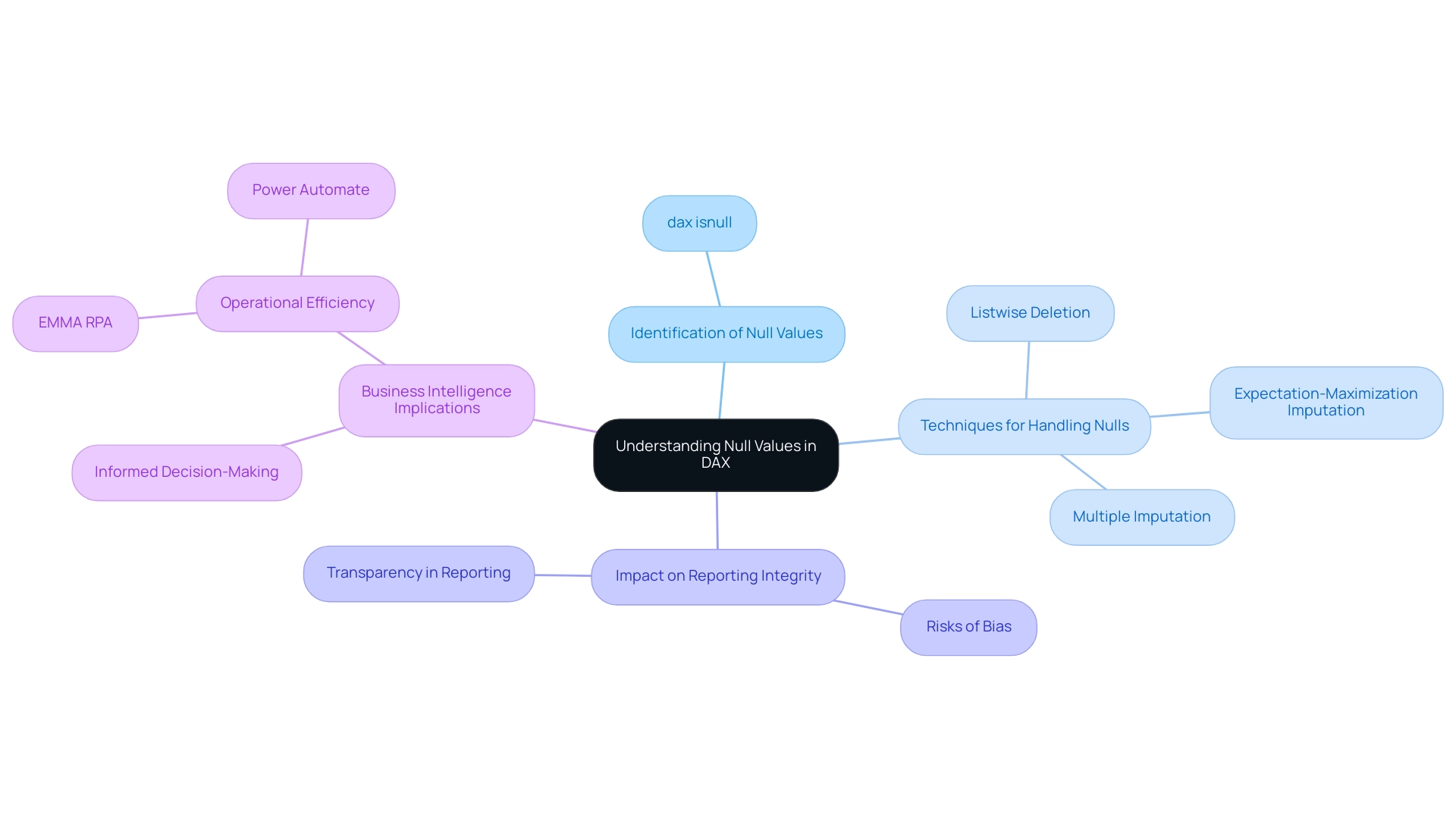
Practical Applications of ISNULL in DAX: Enhancing Data Integrity
The function dax isnull serves a critical purpose in DAX: it identifies null values and allows you to return an alternative in their place. This capability is essential for maintaining information integrity, particularly in reports where clear, trustworthy insights are paramount. For instance, in a sales report, if a customer ID is missing, displaying ‘Unknown Customer’ instead of leaving the field blank ensures a more comprehensive understanding of the data.
The syntax for the function is simple yet powerful: <expression>, <alternate_value>. Here’s a structured approach to implementing it effectively:
- Identify Missing Entries: Begin by using dax isnull to find any missing entries within your dataset. This step is crucial for ensuring your data is complete and reliable.
- Return Alternative Values: Determine what alternative value should be displayed when a non-existent value is encountered. An example implementation could be:
DAX
SalesPerson = IF(ISNULL(Sales[SalesPerson]), "Unknown", Sales[SalesPerson]) - Enhance Readability: By replacing nulls with descriptive text, you significantly improve the readability of your reports and dashboards, making them more user-friendly and actionable.
- Demonstrate Data Integrity: The application of ISNULL not only clarifies the information but also fosters trust among users, as they can comprehend the insights derived from your reports. This practice is essential in the ongoing monitoring and enhancement of ETL pipelines, ensuring integrity across analytics processes.
However, organizations often face challenges in leveraging insights from Power BI dashboards, such as time-consuming report creation and inconsistencies in information. Integrating Robotic Process Automation (RPA) can be a game-changer in this regard, automating repetitive tasks and streamlining the preparation process for DAX functions like ISNULL. This not only enhances operational efficiency but also allows analysts to focus on deriving actionable insights.
A recent study conducted by Precisely and Drexel University’s LeBow College of Business highlighted that organizations prioritizing information integrity saw improved efficiency and cost-cutting benefits. Specifically, 70% of respondents noted that maintaining information integrity led to more reliable analytics outcomes.
By efficiently utilizing the NULL function alongside RPA, analysts can enhance their workflows, presenting clearer and more precise datasets to stakeholders while reinforcing the integrity of their analytics. As one analyst mentioned, “Managing missing entries with precision is vital for precise reporting and decision-making,” highlighting the significance of effective practices in generating insights and enhancing operational efficiency.
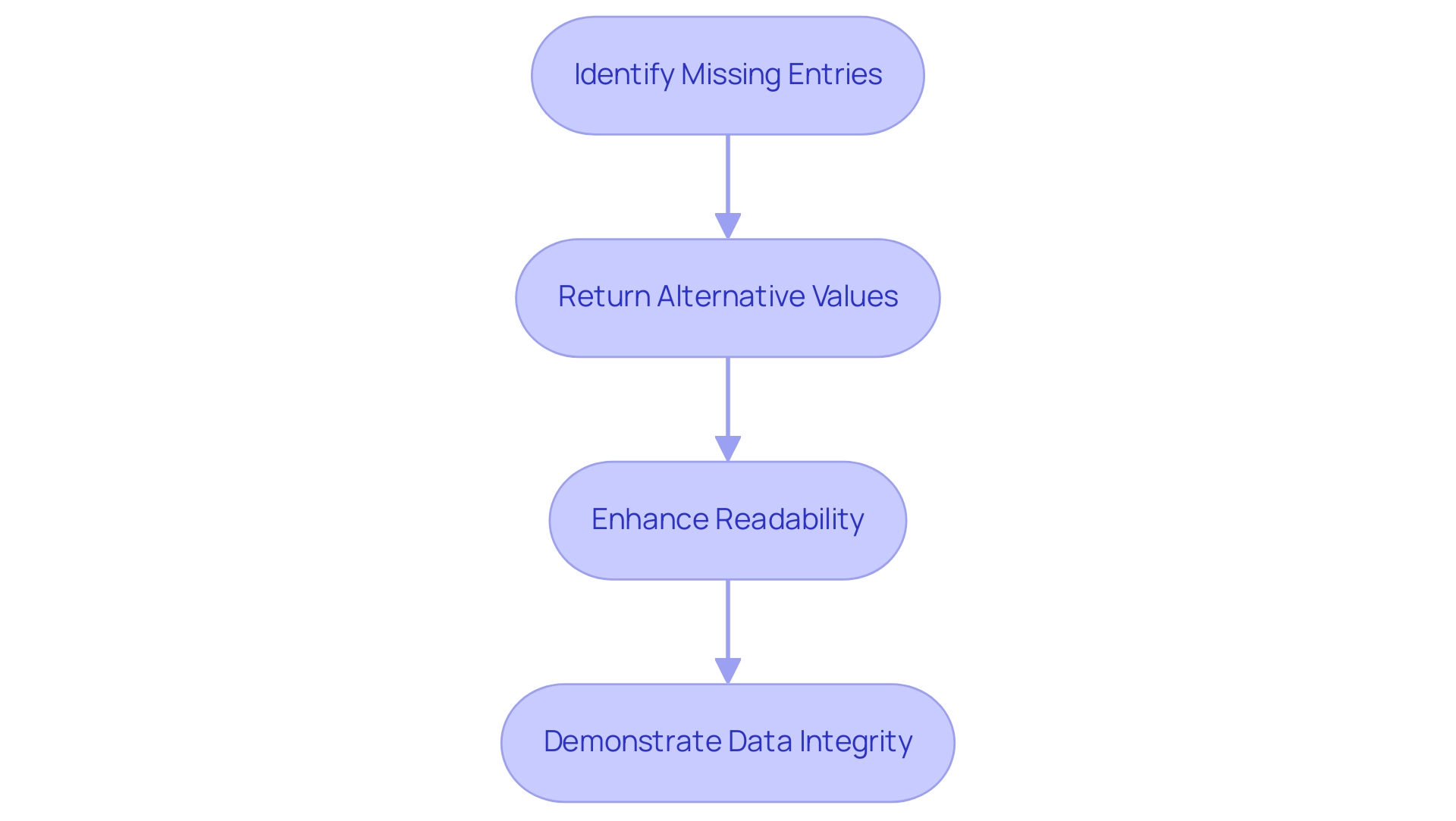
Common Scenarios for Using ISNULL in DAX
Analysts frequently encounter difficulties with null values in different contexts, which makes DAX ISNULL a crucial instrument for efficient information management. With more than 200 hours of learning and guidance from Generative AI specialists, comprehending functions like this one is vital for improving information integrity—particularly when tackling inadequate master information quality and the obstacles to AI implementation in organizations. Here are several scenarios where ISNULL can be particularly beneficial:
- Sales Reports: Null values in sales information may indicate a lack of transactions for specific products. By using ISNULL, you can present ‘No Sales’ instead of leaving this field blank, enhancing clarity for stakeholders:
DAX
SalesStatus = IF(ISNULL(Sales[SalesAmount]), "No Sales", Sales[SalesAmount])
- Customer Data: Missing contact information in customer databases can lead to incomplete records. Applying ISNULL allows you to replace these gaps with placeholders, ensuring that your data remains comprehensive:
DAX
ContactEmail = IF(ISNULL(Customers[Email]), "Not Provided", Customers[Email])
- Employee Records: In HR datasets, null entries for job titles can misrepresent employee roles. Using ISNULL can help fill in default values, maintaining accuracy in reporting:
DAX
JobTitle = IF(ISNULL(Employees[Title]), "Title Not Available", Employees[Title])
- Financial Reporting: Null entries for budget categories can lead to skewed analyses. Implementing ISNULL ensures that your financial reports are clear and informative:
DAX
Budget = IF(ISNULL(Finances[BudgetAmount]), 0, Finances[BudgetAmount])
These scenarios illustrate how the ISNULL function not only enhances data integrity but also ensures that your reports are both comprehensive and user-friendly. As mentioned by Katie Wampole, Research Data Curator, “Managing absent entries effectively is essential for preserving the quality of analysis.” Considering that a notable portion of sales reports might have null values, using COALESCE can result in more dependable analysis outcomes, consistent with best practices in information management.
Moreover, utilizing Small Language Models can deliver customized AI solutions that improve the use of DAX functions such as NULL, while GenAI Workshops provide practical training for teams to efficiently incorporate these methods into their management workflows. By tackling these challenges and utilizing AI tools, organizations can overcome barriers to AI adoption and enhance information quality. Comparable to the functionalities of the SimpleImputer, which can substitute missing entries with mean, mode, median, or a constant, the function offers an uncomplicated method for handling gaps in DAX.
By integrating these practices into your Power BI services, you can enhance reporting efficiency and gain actionable insights.
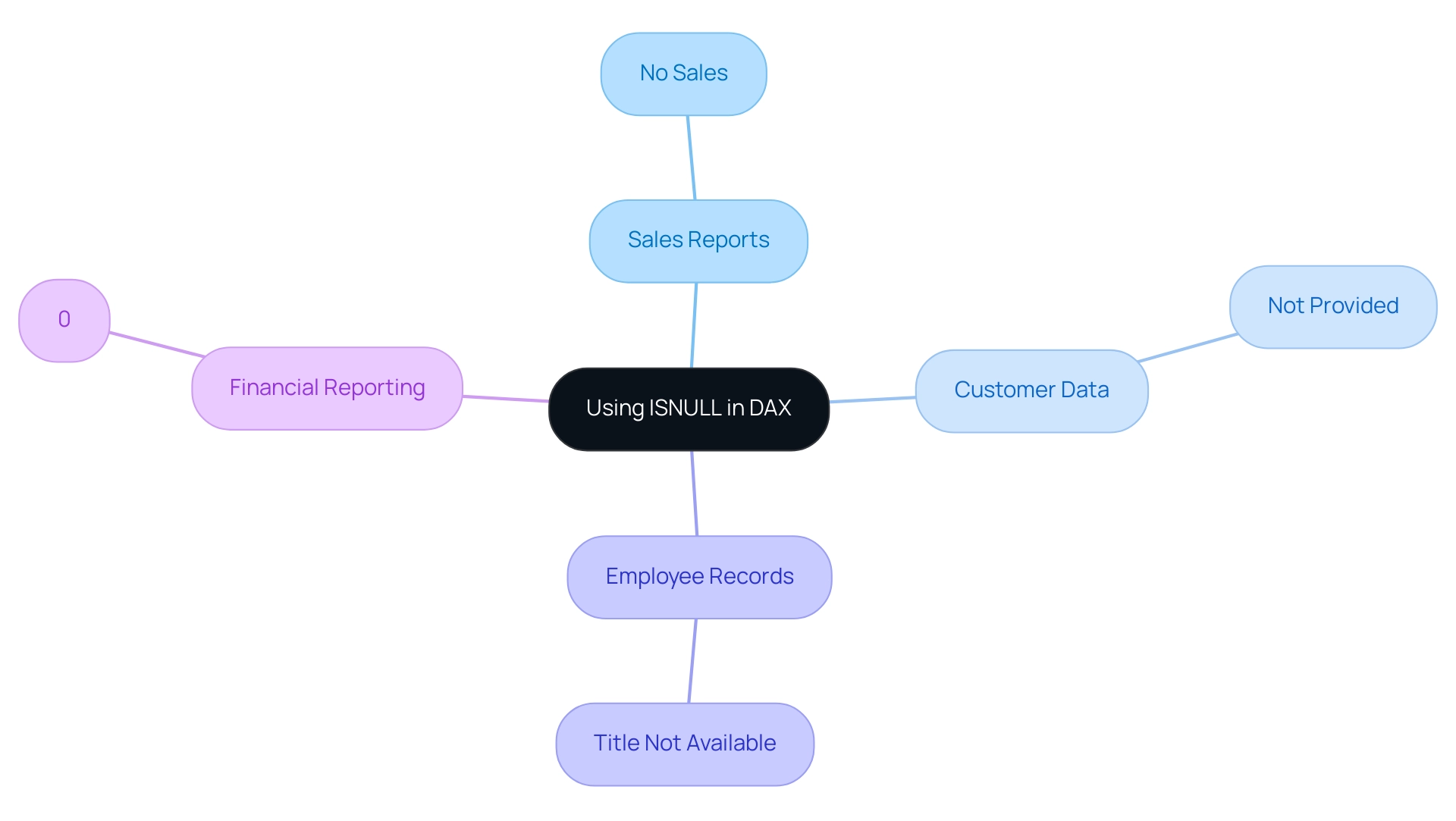
Best Practices for Using ISNULL in DAX
To maximize the effectiveness of the ISNULL function in DAX, adopting the following best practices is essential, particularly in light of the challenges posed by poor master data quality and the barriers to AI adoption in organizations:
-
Always Check for Empty Entries: Before conducting any calculations, use
dax isnullto verify the existence of empty entries. This step is critical to avoid skewed results that could mislead stakeholders. As Yang Li states, “The only arbiter is your test or CV target – does imputation or deletion deliver better, more generalizable models as a result?” This quote highlights the significance of rigorously testing various information handling methods to ensure reliable insights. -
Use Meaningful Alternate Values: When replacing nulls, select substitute values that offer context. This method significantly improves the clarity of reports, making information more interpretable and decision-making more effective.
-
Document Your Code: It’s vital to comment clearly on your use of the function within DAX expressions. This practice not only helps your future self in understanding the logic behind your code but also supports other team members who may work with your reports, fostering a collaborative environment focused on quality.
-
Test Your Reports: After applying
dax isnull, thoroughly review your reports to ensure that outputs align with expectations and that substitutions are relevant and accurate. Performing sensitivity analysis can assist in evaluating the robustness of your findings against assumptions made about absent information, ultimately leading to improved business intelligence. -
Stay Updated: Keep abreast of DAX updates and enhancements. As new functions emerge, they may present more efficient methods for managing null values, improving your analysis workflows and supporting your organization’s data-driven goals. This adaptability is crucial for overcoming the challenges of integrating AI into existing processes.
-
Define and Enforce Quality Standards: A proactive approach to governance includes defining and enforcing clear and consistent quality standards. This practice is crucial to guarantee that information handling techniques, including the application of null-checking, result in dependable and actionable insights that enhance operational efficiency. Enhanced information quality not only improves reporting but also establishes a strong basis for successful AI adoption.
By adhering to these best practices, analysts can ensure that their use of null checks not only meets industry standards but also enhances the overall quality and reliability of their analyses, ultimately empowering organizations to leverage insights for growth and innovation. Effective data handling is integral to unlocking the full potential of Business Intelligence, enabling informed decision-making that propels business success.
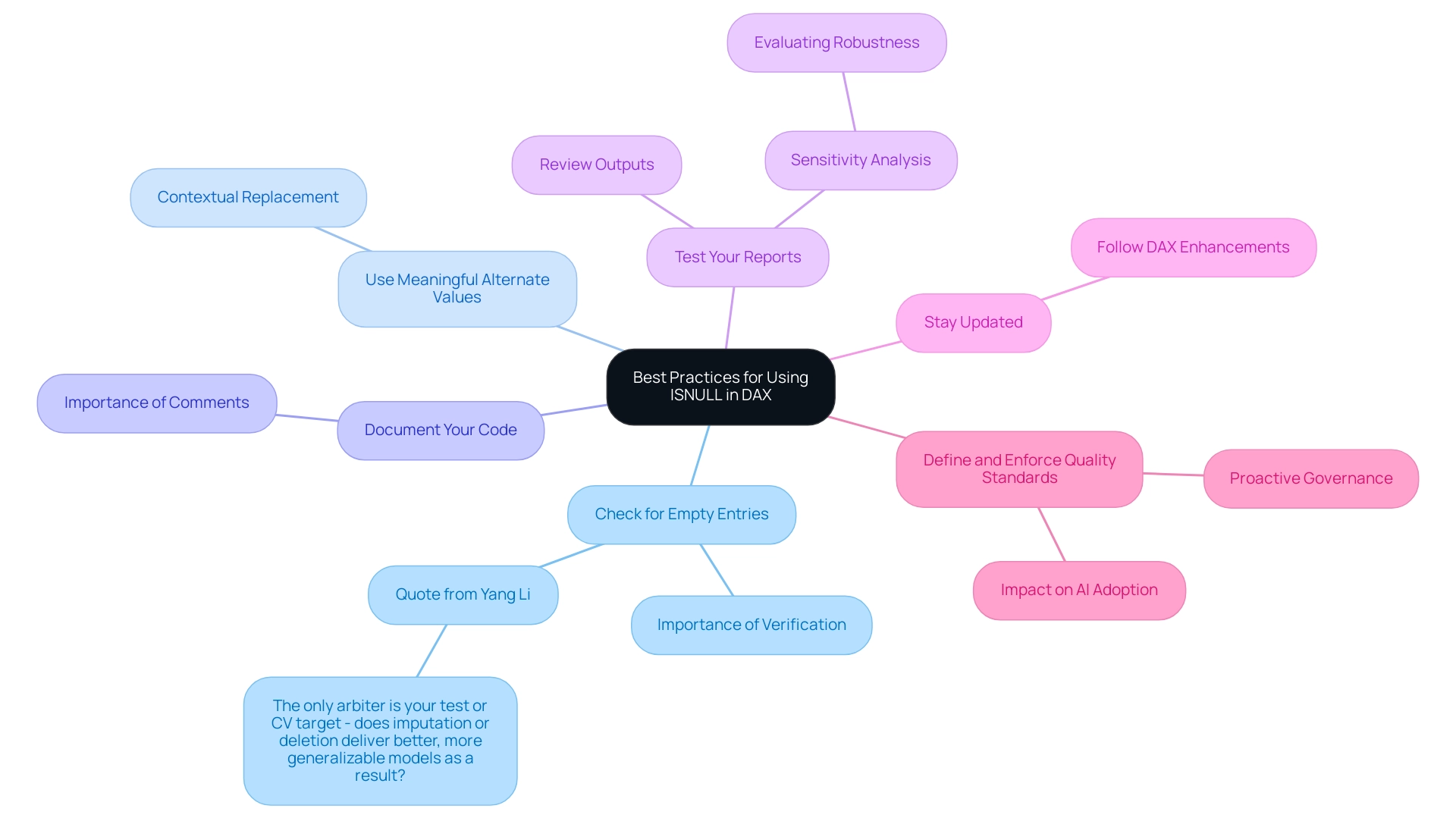
Troubleshooting Common Issues with ISNULL in DAX
When using the dax isnull function in DAX, analysts may encounter several common challenges that reflect broader issues in technology implementation. Here’s how to effectively troubleshoot them:
-
Unexpected Results: If the output seems incorrect, double-check the syntax of your null-check function. Ensure that both the expression and the alternate value are accurately defined to avoid misinterpretations. This is particularly vital in a landscape where tailored AI solutions can streamline the identification of such errors.
-
Performance Issues: In large datasets, dependence on null-check functions can significantly hinder performance. For instance, a user reported a drastic reduction in runtime from 25.2 hours to 102 seconds by optimizing a query that utilized dax isnull in conjunction with OVER. As Steve A. notes,
“Watch out if using a null-check function with a subquery as the replacement_value. Seems like it runs the subquery even if the check_expression value is not NULL which doesn’t help performance.”
Limit the use of dax isnull to essential cases and consider alternatives like COALESCE, which can enhance efficiency, particularly in data-rich environments. RPA can also be leveraged here to automate repetitive data checks, further improving performance. -
Null vs. Blank: Recognizing that null values, particularly when using dax isnull, and blank values are distinct is essential. For checks against blanks, employ the
BLANK()function or modify your conditions accordingly to ensure accurate results. This distinction can be crucial for leveraging Business Intelligence effectively to gain actionable insights. -
Logical Errors: Scrutinize the logic applied in your DAX expressions and consider using dax isnull to ensure comprehensive coverage of all scenarios. Additional conditions may be necessary to capture edge cases effectively, which is vital for overcoming common challenges in report creation and ensuring information consistency. RPA tools can assist in automating logic checks to enhance accuracy.
-
Documentation Gaps: If uncertainties arise regarding how this function integrates with other DAX functions, consulting official documentation or engaging with community forums can yield valuable insights and enhance your understanding. This proactive approach is essential in navigating the complexities of technology implementation.
Additionally, with the upcoming event on DAX handling of Boolean expressions scheduled for February 18-20, 2025, in Phoenix, analysts may find it advantageous to attend for further insights and networking opportunities. Such events can provide critical knowledge that aids in overcoming specific challenges related to technology implementation.
By proactively addressing these common issues, data analysts can significantly improve their proficiency with the ISNULL function, leading to more efficient data analysis and optimal performance. Furthermore, just as addressing a blockage in a ganged switch requires systematic troubleshooting, so too does mastering DAX functions demand a thorough approach to problem-solving.
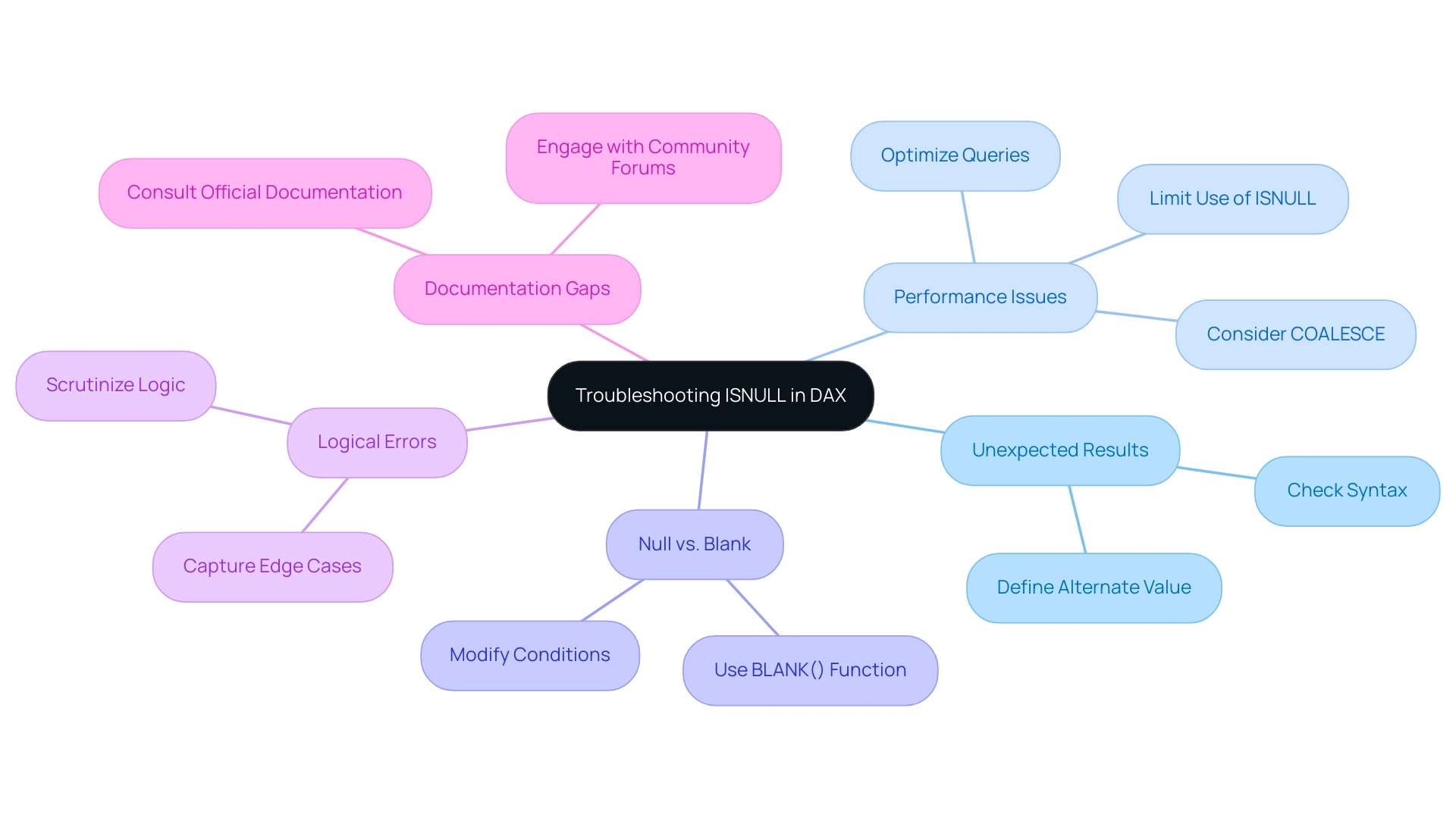
Conclusion
Addressing null values in data analysis is not just a technical requirement; it is a fundamental necessity for ensuring the reliability and clarity of insights derived from data. Throughout this article, the critical role of the ISNULL function in DAX has been underscored, highlighting its ability to transform incomplete datasets into comprehensive reports. By replacing null entries with meaningful alternatives, organizations can significantly enhance the integrity of their analytics, thereby fostering informed decision-making.
The practical applications of ISNULL in various scenarios, from sales reports to financial analyses, illustrate its versatility in improving data quality. Best practices include:
- Checking for null values
- Using contextually relevant alternatives
- Documenting code
These practices are essential for maximizing the effectiveness of this function. Additionally, understanding and troubleshooting common issues with ISNULL ensures analysts can maintain optimal performance and accuracy in their reports.
Ultimately, embracing these strategies not only empowers data professionals to streamline their workflows but also contributes to a robust data-driven culture within organizations. By effectively managing null values, businesses can harness the full potential of their data, paving the way for informed strategies and sustained growth in an increasingly competitive landscape.

